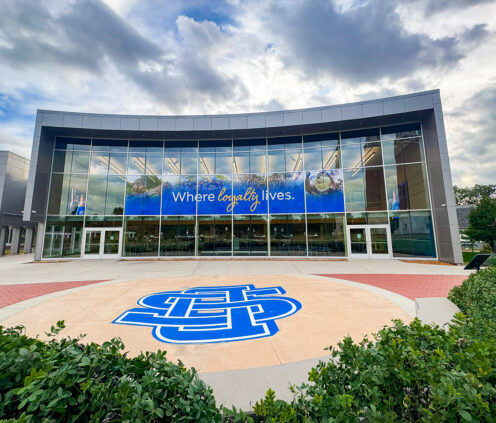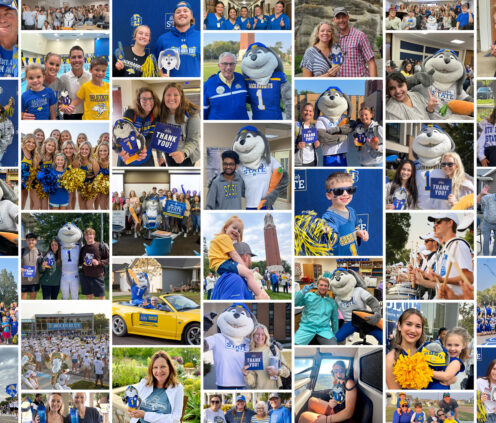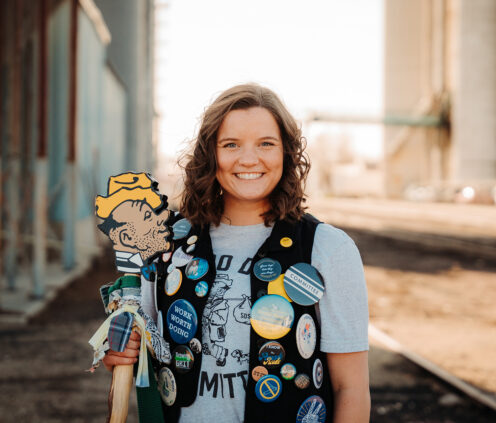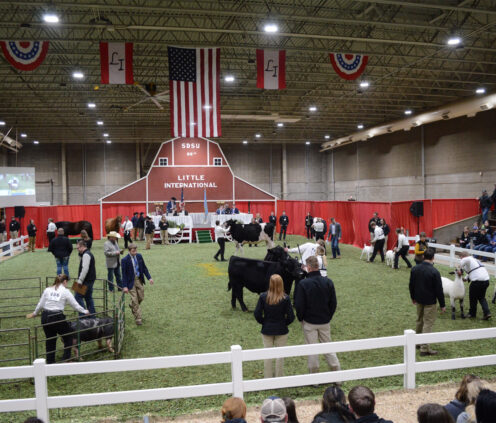Bronze and Beloved: Dirty Lil’s Legacy
While the Dirty Lil statue was installed ten years ago, Lil herself has endured for decades.
Story published October 2023
On October 4, 2013, SDSU’s beloved Dirty Lil took up a permanent post alongside the Weary Wil statue outside the Hobo Day Gallery of the Student Union.
Though 2023 marked the ten-year anniversary of Lil’s statue installation, the origins of this campus icon date back over four decades – and her likeness’s story is just as unique as her male counterpart’s.
While Weary Wil made his first appearance at Hobo Day in 1950, the yellow and blue community tried out a few versions of a female homecoming leader that failed to stick. One such example lost to time was Semanthy Jane, a suffragette designed to inspire Jackrabbits to register to vote. Over the years, other caricatures rose and fell in popularity, though no iteration seemed to do justice to conveying the joviality of Hobo Day.
Though the university seemed to have a consensus that Wil was in need of a female representative to help ring in Hobo Day, that figure didn’t arrive at our history books until 1976, when Barbara Strandell (1973) served as the first Dirty Lil.

Campus lore claims that the origin of Dirty Lil sprung into being the summer before the 65th Hobo Day, where the character was derived from a drinking song that the Hobo Day Committee came across in a book.
With her ragged clothing, disheveled appearance, and hippie style illustrating the epitome of bum life, the university had finally landed on a character fitting to accompany Weary Wil.
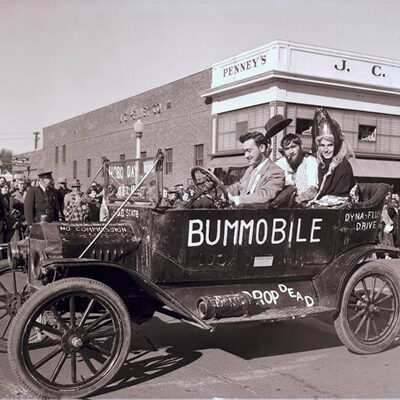
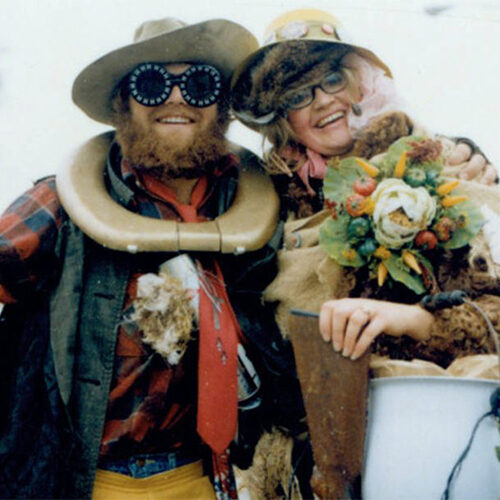
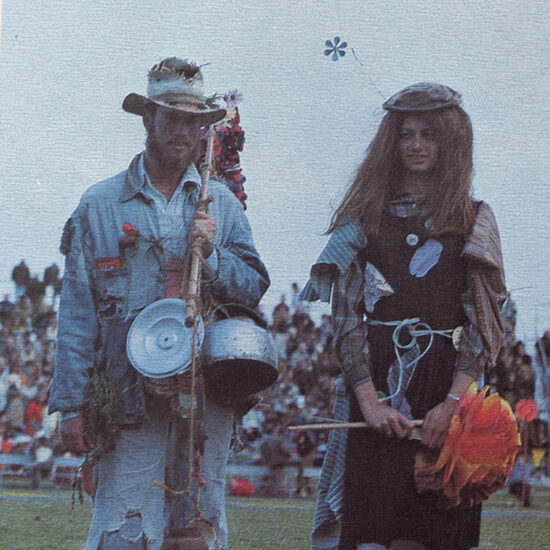
Remaining in step with him throughout history since her first appearance nearly fifty years ago, Lil continues to be critical in building cheer and spreading Hobo hype each fall.
Much like in life, Lil came into being after Wil, and much like in life, Wil never seemed complete without her. Wil’s statue was installed outside the Student Union on November 2011. Nearly two years later, the same sculptor, David Anderson ('66) of Loveland, Colorado, would cast a similar Dirty Lil and install it at Wil’s side.

The larger-than-life sculptures measure a staggering 8 ½ feet tall and weigh 1,000 pounds each; Wil gazes in the distance with a bindle propped on his shoulder while Lil points in the direction of where the Pugsley Student Union sign once stood, a flower tucked behind her ear and a dimpled smile forever cast across her face.
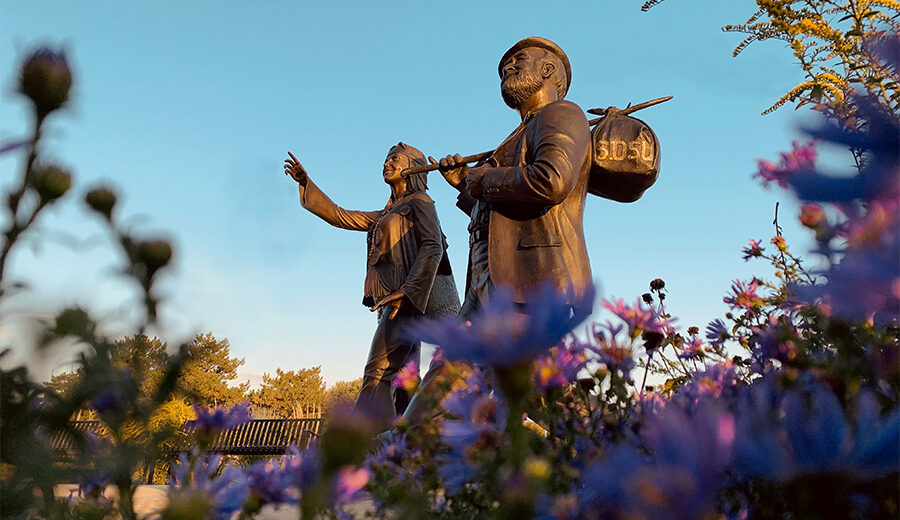
While Anderson’s creative gusto was pivotal in bringing SDSU’s favorite dynamic duo to life, the initiative wouldn’t have happened without monumental philanthropy – and the memory of one standout Jackrabbit.
A native of Menno, South Dakota, Anita Quast Lawe (1940) was incredibly involved in campus during her time as a student. She sang in the chorus, served as her class secretary, joined multiple sororities, and participated in countless clubs.
Most notably, Anita was named the 1938 Hobo Day Queen – a form of homecoming royalty that was discontinued following the creation of Wil and Lil.

In 2013, the Robert and Anita Quast Lawe Foundation, led by Robert and Anita’s daughter, Lonnie Humphries, stepped forward with funding for the statue project, and David Anderson set about fashioning SDSU’s Dirty Lil.
“The goal was to portray the joyful eagerness and experience of discovery, learning, and hope for the future that made my mother’s college years at SDSU so special to her, and to make Lil a representation of the same for all students, both now and in years to come.” - Lonnie Humphries
In light of both her family’s philanthropy and her jam-packed days as a Jackrabbit, it was only fitting that Anita serve as the facial model for the Dirty Lil statue.
The sculpture itself is based off a photo of Anita taken in the 1950s while she worked as an airline stewardess.
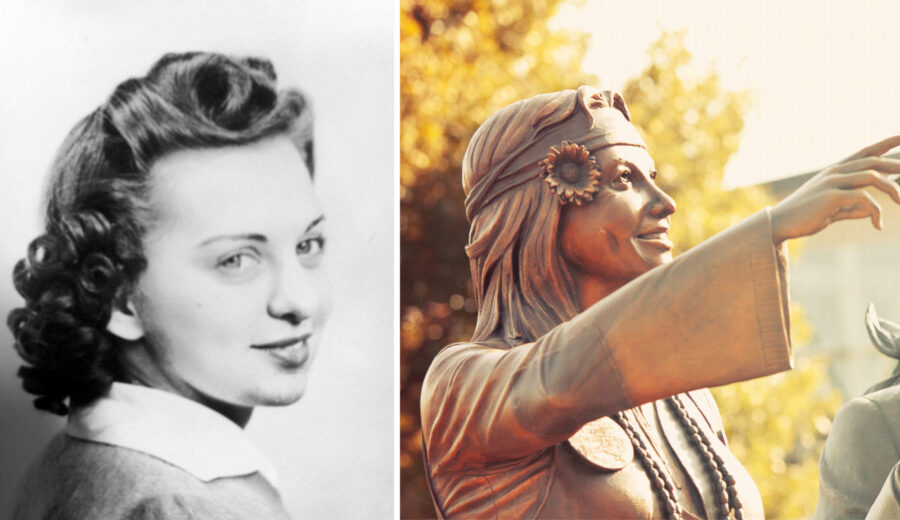
David AndersonDirty Lil conveys a woman of strength and confidence, proud to be a ‘Hobo by Choice’ and proud to be a part of the SDSU family.

Lonnie echoed Anderson’s determination that Lil should adequately represent the essence of Hobo Day, noting that the project wasn’t just about recreating a caricature; it involved capturing a spirit of something much grander.
Through the talents and generosity of SDSU alumni, the Dirty Lil statue, along with Weary Wil, has become an infamous campus landmark, permanently standing watch over the thousands of Jackrabbits that pass by them each day…forever returning to the fall traditions that inspired our beloved and whimsical hobo icons.
As Lonnie said at Lil’s grand unveiling ceremony a decade ago, “It is very endearing to have her memorialized this way, and I’ve also come to gain further understanding of what stood behind some of the best years of her life by learning more about SDSU, its traditions, and its stories. I’m happy that she gets to go back home.”
For Anita Quast Lawe, along with the Dirty Lil statue modeled after her, all rails truly do lead home.

